Analyzing Complex Parameters in the Grand Ethiopian Renaissance Dam
VerifiedAdded on 2023/04/22
|9
|1957
|312
Report
AI Summary
This report provides an in-depth analysis of the complex parameters affecting the construction of the Grand Ethiopian Renaissance Dam (GERD) on the Blue Nile River in Ethiopia. It evaluates the political, structural, technical, temporal, directional, transportation, social, and environmental factors contributing to the project's complexities. Using radar diagrams, the report assesses the level of influence each parameter exerts on the project's progress, highlighting the challenges posed by international relations, structural changes, and environmental concerns. The analysis aims to assist stakeholders in developing strategies for mitigating these complexities and ensuring the timely completion of this significant infrastructure project. Desklib provides access to this and other solved assignments to aid students in their studies.
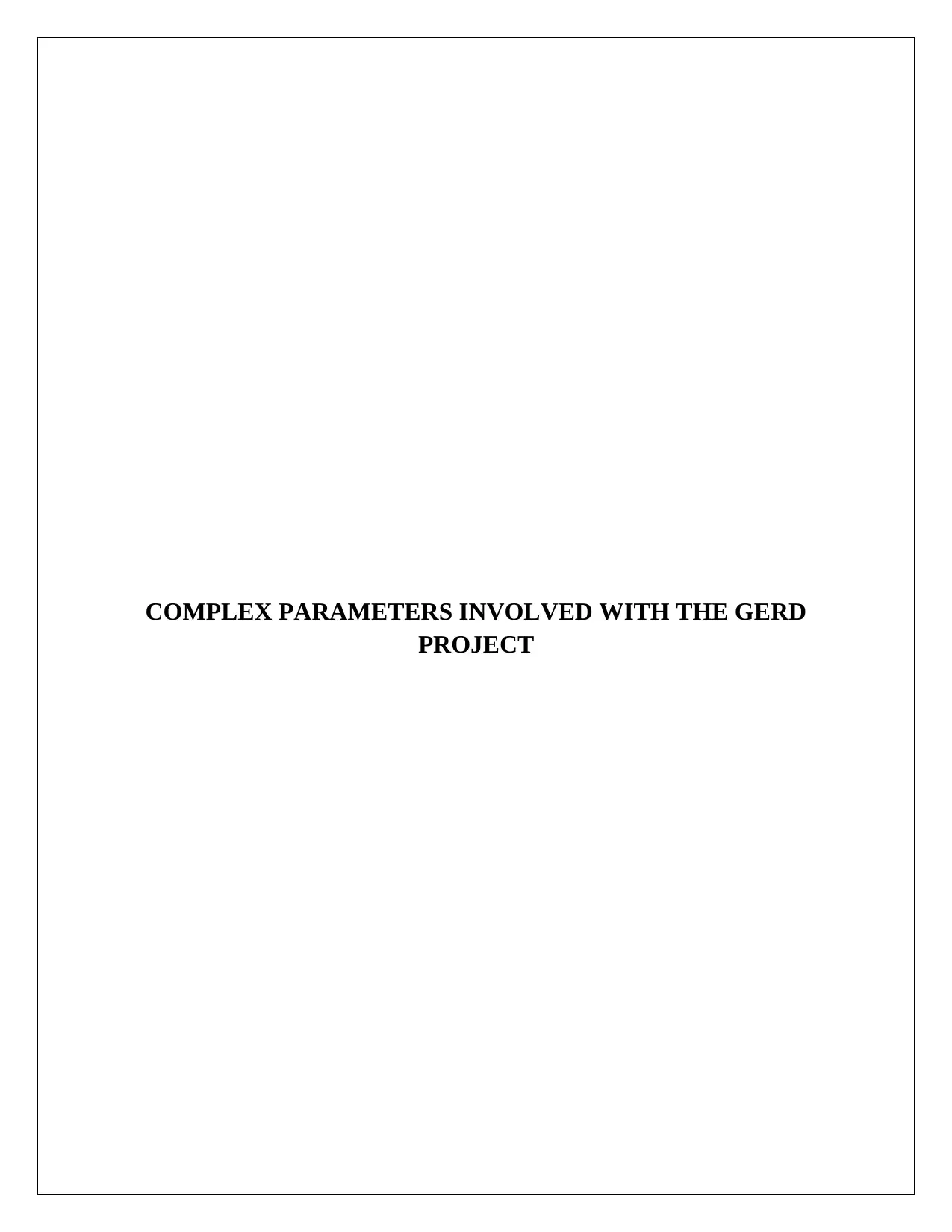
COMPLEX PARAMETERS INVOLVED WITH THE GERD
PROJECT
PROJECT
Paraphrase This Document
Need a fresh take? Get an instant paraphrase of this document with our AI Paraphraser
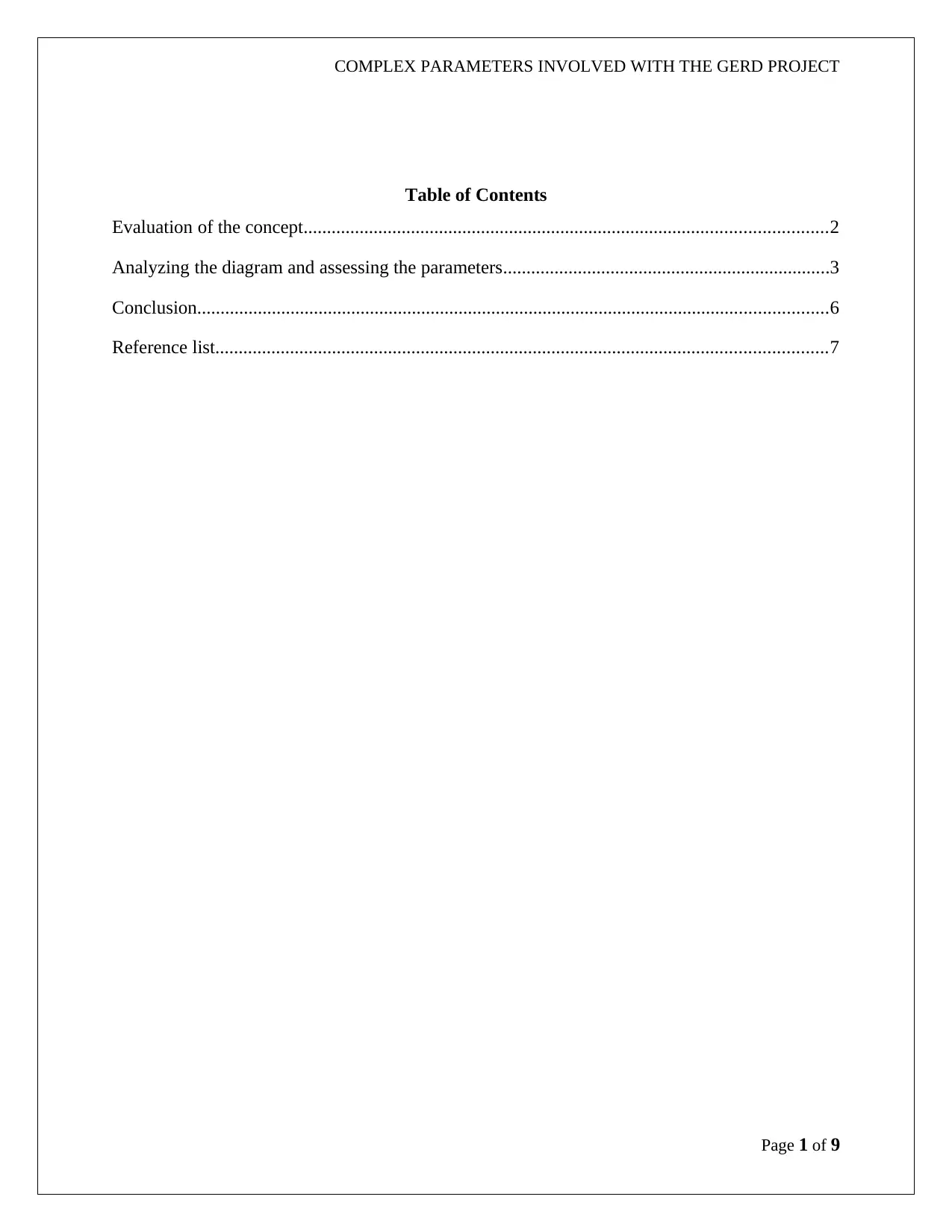
COMPLEX PARAMETERS INVOLVED WITH THE GERD PROJECT
Table of Contents
Evaluation of the concept................................................................................................................2
Analyzing the diagram and assessing the parameters......................................................................3
Conclusion.......................................................................................................................................6
Reference list...................................................................................................................................7
Page 1 of 9
Table of Contents
Evaluation of the concept................................................................................................................2
Analyzing the diagram and assessing the parameters......................................................................3
Conclusion.......................................................................................................................................6
Reference list...................................................................................................................................7
Page 1 of 9
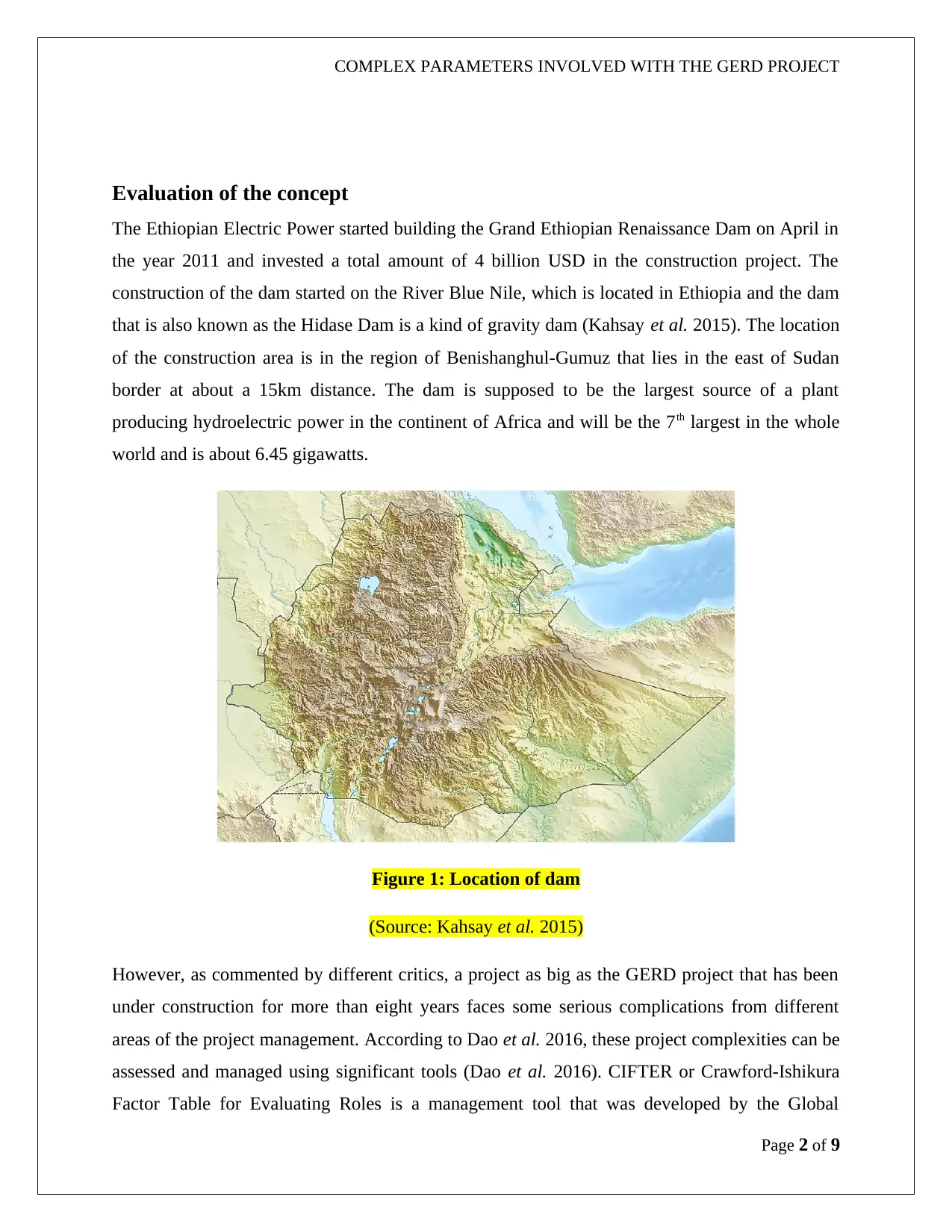
COMPLEX PARAMETERS INVOLVED WITH THE GERD PROJECT
Evaluation of the concept
The Ethiopian Electric Power started building the Grand Ethiopian Renaissance Dam on April in
the year 2011 and invested a total amount of 4 billion USD in the construction project. The
construction of the dam started on the River Blue Nile, which is located in Ethiopia and the dam
that is also known as the Hidase Dam is a kind of gravity dam (Kahsay et al. 2015). The location
of the construction area is in the region of Benishanghul-Gumuz that lies in the east of Sudan
border at about a 15km distance. The dam is supposed to be the largest source of a plant
producing hydroelectric power in the continent of Africa and will be the 7th largest in the whole
world and is about 6.45 gigawatts.
Figure 1: Location of dam
(Source: Kahsay et al. 2015)
However, as commented by different critics, a project as big as the GERD project that has been
under construction for more than eight years faces some serious complications from different
areas of the project management. According to Dao et al. 2016, these project complexities can be
assessed and managed using significant tools (Dao et al. 2016). CIFTER or Crawford-Ishikura
Factor Table for Evaluating Roles is a management tool that was developed by the Global
Page 2 of 9
Evaluation of the concept
The Ethiopian Electric Power started building the Grand Ethiopian Renaissance Dam on April in
the year 2011 and invested a total amount of 4 billion USD in the construction project. The
construction of the dam started on the River Blue Nile, which is located in Ethiopia and the dam
that is also known as the Hidase Dam is a kind of gravity dam (Kahsay et al. 2015). The location
of the construction area is in the region of Benishanghul-Gumuz that lies in the east of Sudan
border at about a 15km distance. The dam is supposed to be the largest source of a plant
producing hydroelectric power in the continent of Africa and will be the 7th largest in the whole
world and is about 6.45 gigawatts.
Figure 1: Location of dam
(Source: Kahsay et al. 2015)
However, as commented by different critics, a project as big as the GERD project that has been
under construction for more than eight years faces some serious complications from different
areas of the project management. According to Dao et al. 2016, these project complexities can be
assessed and managed using significant tools (Dao et al. 2016). CIFTER or Crawford-Ishikura
Factor Table for Evaluating Roles is a management tool that was developed by the Global
Page 2 of 9
⊘ This is a preview!⊘
Do you want full access?
Subscribe today to unlock all pages.

Trusted by 1+ million students worldwide
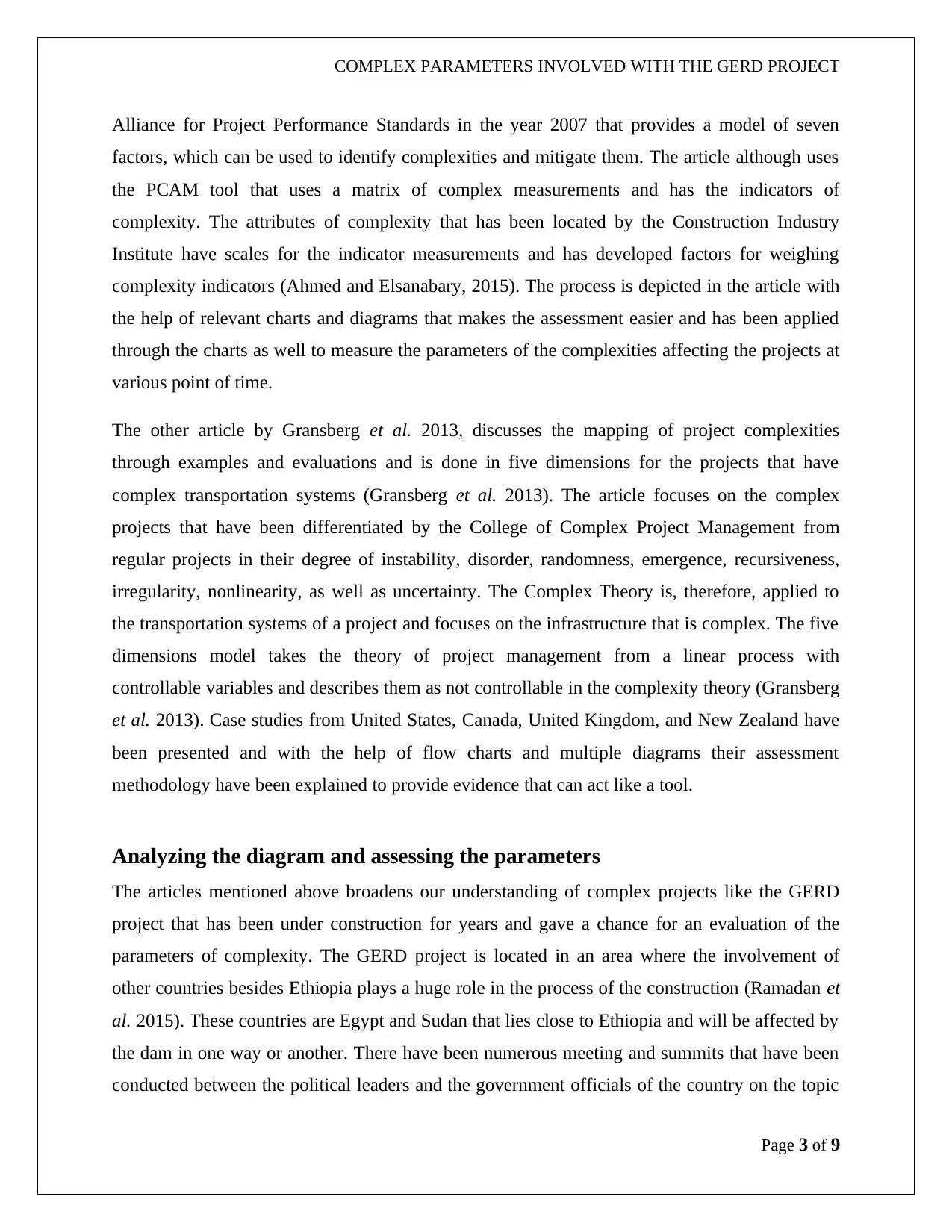
COMPLEX PARAMETERS INVOLVED WITH THE GERD PROJECT
Alliance for Project Performance Standards in the year 2007 that provides a model of seven
factors, which can be used to identify complexities and mitigate them. The article although uses
the PCAM tool that uses a matrix of complex measurements and has the indicators of
complexity. The attributes of complexity that has been located by the Construction Industry
Institute have scales for the indicator measurements and has developed factors for weighing
complexity indicators (Ahmed and Elsanabary, 2015). The process is depicted in the article with
the help of relevant charts and diagrams that makes the assessment easier and has been applied
through the charts as well to measure the parameters of the complexities affecting the projects at
various point of time.
The other article by Gransberg et al. 2013, discusses the mapping of project complexities
through examples and evaluations and is done in five dimensions for the projects that have
complex transportation systems (Gransberg et al. 2013). The article focuses on the complex
projects that have been differentiated by the College of Complex Project Management from
regular projects in their degree of instability, disorder, randomness, emergence, recursiveness,
irregularity, nonlinearity, as well as uncertainty. The Complex Theory is, therefore, applied to
the transportation systems of a project and focuses on the infrastructure that is complex. The five
dimensions model takes the theory of project management from a linear process with
controllable variables and describes them as not controllable in the complexity theory (Gransberg
et al. 2013). Case studies from United States, Canada, United Kingdom, and New Zealand have
been presented and with the help of flow charts and multiple diagrams their assessment
methodology have been explained to provide evidence that can act like a tool.
Analyzing the diagram and assessing the parameters
The articles mentioned above broadens our understanding of complex projects like the GERD
project that has been under construction for years and gave a chance for an evaluation of the
parameters of complexity. The GERD project is located in an area where the involvement of
other countries besides Ethiopia plays a huge role in the process of the construction (Ramadan et
al. 2015). These countries are Egypt and Sudan that lies close to Ethiopia and will be affected by
the dam in one way or another. There have been numerous meeting and summits that have been
conducted between the political leaders and the government officials of the country on the topic
Page 3 of 9
Alliance for Project Performance Standards in the year 2007 that provides a model of seven
factors, which can be used to identify complexities and mitigate them. The article although uses
the PCAM tool that uses a matrix of complex measurements and has the indicators of
complexity. The attributes of complexity that has been located by the Construction Industry
Institute have scales for the indicator measurements and has developed factors for weighing
complexity indicators (Ahmed and Elsanabary, 2015). The process is depicted in the article with
the help of relevant charts and diagrams that makes the assessment easier and has been applied
through the charts as well to measure the parameters of the complexities affecting the projects at
various point of time.
The other article by Gransberg et al. 2013, discusses the mapping of project complexities
through examples and evaluations and is done in five dimensions for the projects that have
complex transportation systems (Gransberg et al. 2013). The article focuses on the complex
projects that have been differentiated by the College of Complex Project Management from
regular projects in their degree of instability, disorder, randomness, emergence, recursiveness,
irregularity, nonlinearity, as well as uncertainty. The Complex Theory is, therefore, applied to
the transportation systems of a project and focuses on the infrastructure that is complex. The five
dimensions model takes the theory of project management from a linear process with
controllable variables and describes them as not controllable in the complexity theory (Gransberg
et al. 2013). Case studies from United States, Canada, United Kingdom, and New Zealand have
been presented and with the help of flow charts and multiple diagrams their assessment
methodology have been explained to provide evidence that can act like a tool.
Analyzing the diagram and assessing the parameters
The articles mentioned above broadens our understanding of complex projects like the GERD
project that has been under construction for years and gave a chance for an evaluation of the
parameters of complexity. The GERD project is located in an area where the involvement of
other countries besides Ethiopia plays a huge role in the process of the construction (Ramadan et
al. 2015). These countries are Egypt and Sudan that lies close to Ethiopia and will be affected by
the dam in one way or another. There have been numerous meeting and summits that have been
conducted between the political leaders and the government officials of the country on the topic
Page 3 of 9
Paraphrase This Document
Need a fresh take? Get an instant paraphrase of this document with our AI Paraphraser
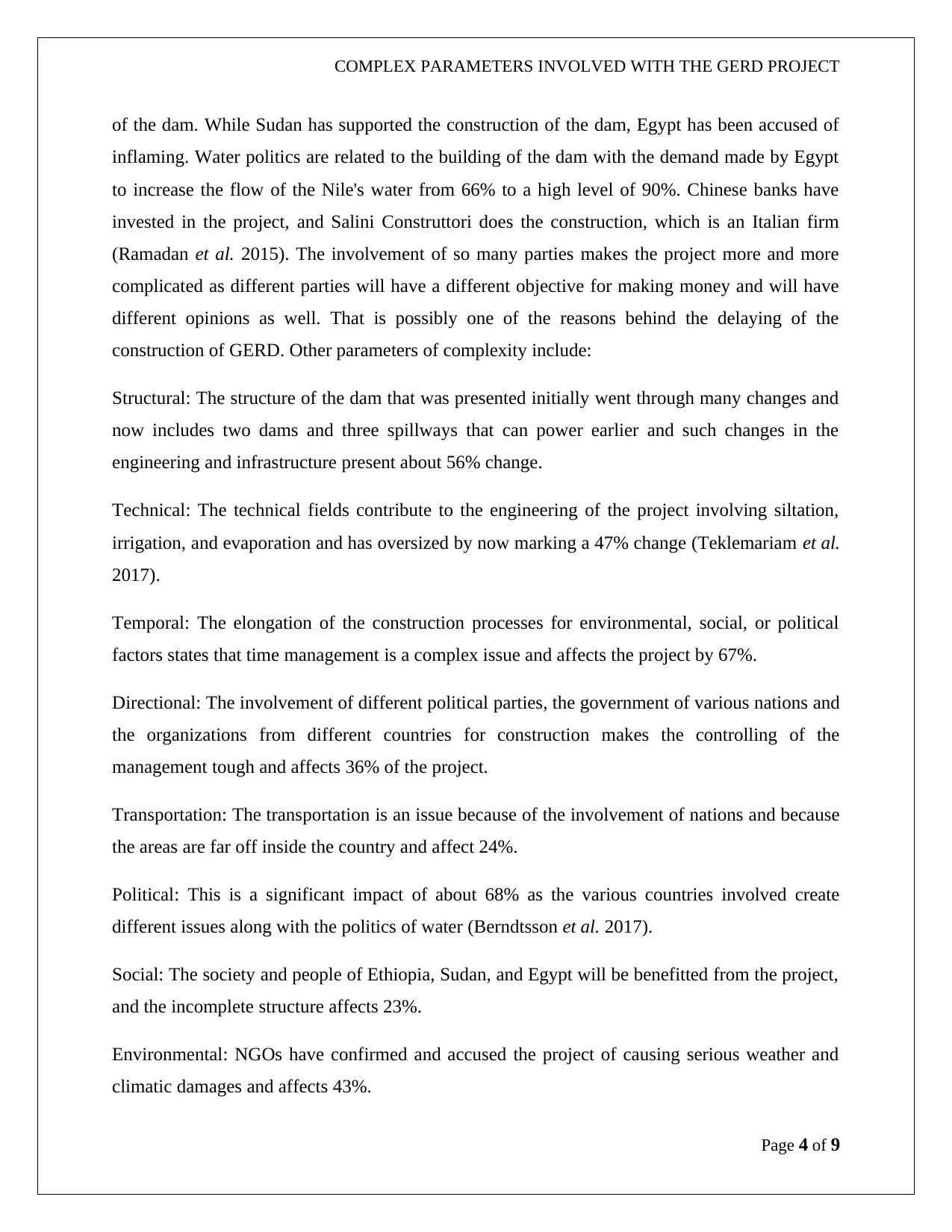
COMPLEX PARAMETERS INVOLVED WITH THE GERD PROJECT
of the dam. While Sudan has supported the construction of the dam, Egypt has been accused of
inflaming. Water politics are related to the building of the dam with the demand made by Egypt
to increase the flow of the Nile's water from 66% to a high level of 90%. Chinese banks have
invested in the project, and Salini Construttori does the construction, which is an Italian firm
(Ramadan et al. 2015). The involvement of so many parties makes the project more and more
complicated as different parties will have a different objective for making money and will have
different opinions as well. That is possibly one of the reasons behind the delaying of the
construction of GERD. Other parameters of complexity include:
Structural: The structure of the dam that was presented initially went through many changes and
now includes two dams and three spillways that can power earlier and such changes in the
engineering and infrastructure present about 56% change.
Technical: The technical fields contribute to the engineering of the project involving siltation,
irrigation, and evaporation and has oversized by now marking a 47% change (Teklemariam et al.
2017).
Temporal: The elongation of the construction processes for environmental, social, or political
factors states that time management is a complex issue and affects the project by 67%.
Directional: The involvement of different political parties, the government of various nations and
the organizations from different countries for construction makes the controlling of the
management tough and affects 36% of the project.
Transportation: The transportation is an issue because of the involvement of nations and because
the areas are far off inside the country and affect 24%.
Political: This is a significant impact of about 68% as the various countries involved create
different issues along with the politics of water (Berndtsson et al. 2017).
Social: The society and people of Ethiopia, Sudan, and Egypt will be benefitted from the project,
and the incomplete structure affects 23%.
Environmental: NGOs have confirmed and accused the project of causing serious weather and
climatic damages and affects 43%.
Page 4 of 9
of the dam. While Sudan has supported the construction of the dam, Egypt has been accused of
inflaming. Water politics are related to the building of the dam with the demand made by Egypt
to increase the flow of the Nile's water from 66% to a high level of 90%. Chinese banks have
invested in the project, and Salini Construttori does the construction, which is an Italian firm
(Ramadan et al. 2015). The involvement of so many parties makes the project more and more
complicated as different parties will have a different objective for making money and will have
different opinions as well. That is possibly one of the reasons behind the delaying of the
construction of GERD. Other parameters of complexity include:
Structural: The structure of the dam that was presented initially went through many changes and
now includes two dams and three spillways that can power earlier and such changes in the
engineering and infrastructure present about 56% change.
Technical: The technical fields contribute to the engineering of the project involving siltation,
irrigation, and evaporation and has oversized by now marking a 47% change (Teklemariam et al.
2017).
Temporal: The elongation of the construction processes for environmental, social, or political
factors states that time management is a complex issue and affects the project by 67%.
Directional: The involvement of different political parties, the government of various nations and
the organizations from different countries for construction makes the controlling of the
management tough and affects 36% of the project.
Transportation: The transportation is an issue because of the involvement of nations and because
the areas are far off inside the country and affect 24%.
Political: This is a significant impact of about 68% as the various countries involved create
different issues along with the politics of water (Berndtsson et al. 2017).
Social: The society and people of Ethiopia, Sudan, and Egypt will be benefitted from the project,
and the incomplete structure affects 23%.
Environmental: NGOs have confirmed and accused the project of causing serious weather and
climatic damages and affects 43%.
Page 4 of 9
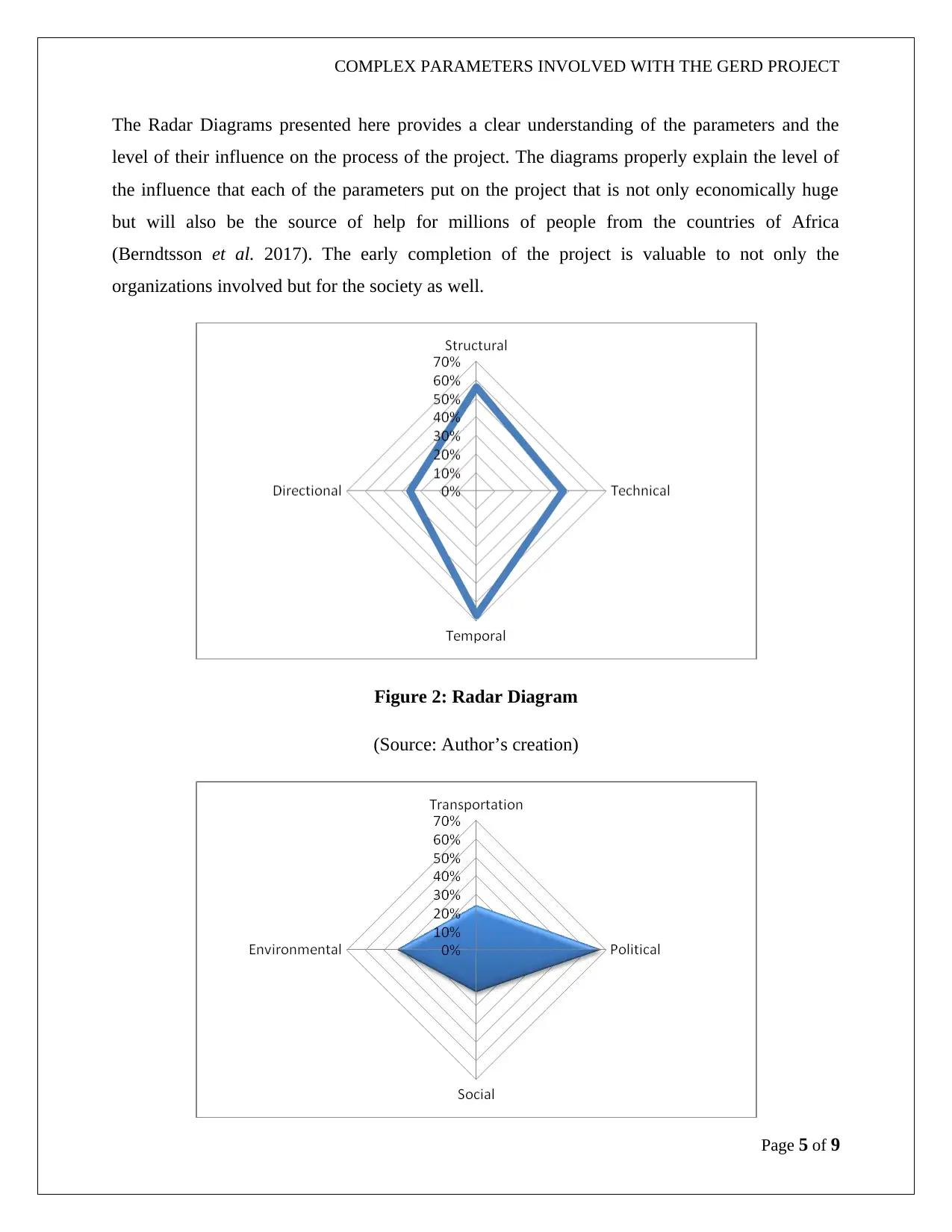
COMPLEX PARAMETERS INVOLVED WITH THE GERD PROJECT
The Radar Diagrams presented here provides a clear understanding of the parameters and the
level of their influence on the process of the project. The diagrams properly explain the level of
the influence that each of the parameters put on the project that is not only economically huge
but will also be the source of help for millions of people from the countries of Africa
(Berndtsson et al. 2017). The early completion of the project is valuable to not only the
organizations involved but for the society as well.
Figure 2: Radar Diagram
(Source: Author’s creation)
Page 5 of 9
The Radar Diagrams presented here provides a clear understanding of the parameters and the
level of their influence on the process of the project. The diagrams properly explain the level of
the influence that each of the parameters put on the project that is not only economically huge
but will also be the source of help for millions of people from the countries of Africa
(Berndtsson et al. 2017). The early completion of the project is valuable to not only the
organizations involved but for the society as well.
Figure 2: Radar Diagram
(Source: Author’s creation)
Page 5 of 9
⊘ This is a preview!⊘
Do you want full access?
Subscribe today to unlock all pages.

Trusted by 1+ million students worldwide

COMPLEX PARAMETERS INVOLVED WITH THE GERD PROJECT
Figure 3: Radar Diagram
(Source: Author’s creation)
The parameters presented here have provided definite proof of how the different issues created
by the people involved with the project and some natural factors pose serious complications in
the course of a project. The different conditions responsible have different attributes and have to
be addressed in different ways to mitigate the troubles the build-up on a day to day basis
(Wheeler et al. 2016). The meeting between the neighbouring countries might shortly help them
solve the issues of water, and the effect of it on the population of the country and the
management team has to be more responsible for preserving the environment while constructing
the dam or some serious repercussions might be coming their way shortly.
Conclusion
The paper has been able to detail successfully the problems and the complications that affect the
construction of the Grand Ethiopian Renaissance Dam on the River Blue Nile in Ethiopia. With
the help of the Radar Diagrams and by judging properly the processes that are involved in
making it, the parameters of the complexities that hinder the completion of the dam have been
assessed. The assessment done here will help the parties or the organizations involved with the
construction of the dam to develop plans for early completion of the project by mitigating the
political, structural, or directional complexities on time.
Page 6 of 9
Figure 3: Radar Diagram
(Source: Author’s creation)
The parameters presented here have provided definite proof of how the different issues created
by the people involved with the project and some natural factors pose serious complications in
the course of a project. The different conditions responsible have different attributes and have to
be addressed in different ways to mitigate the troubles the build-up on a day to day basis
(Wheeler et al. 2016). The meeting between the neighbouring countries might shortly help them
solve the issues of water, and the effect of it on the population of the country and the
management team has to be more responsible for preserving the environment while constructing
the dam or some serious repercussions might be coming their way shortly.
Conclusion
The paper has been able to detail successfully the problems and the complications that affect the
construction of the Grand Ethiopian Renaissance Dam on the River Blue Nile in Ethiopia. With
the help of the Radar Diagrams and by judging properly the processes that are involved in
making it, the parameters of the complexities that hinder the completion of the dam have been
assessed. The assessment done here will help the parties or the organizations involved with the
construction of the dam to develop plans for early completion of the project by mitigating the
political, structural, or directional complexities on time.
Page 6 of 9
Paraphrase This Document
Need a fresh take? Get an instant paraphrase of this document with our AI Paraphraser
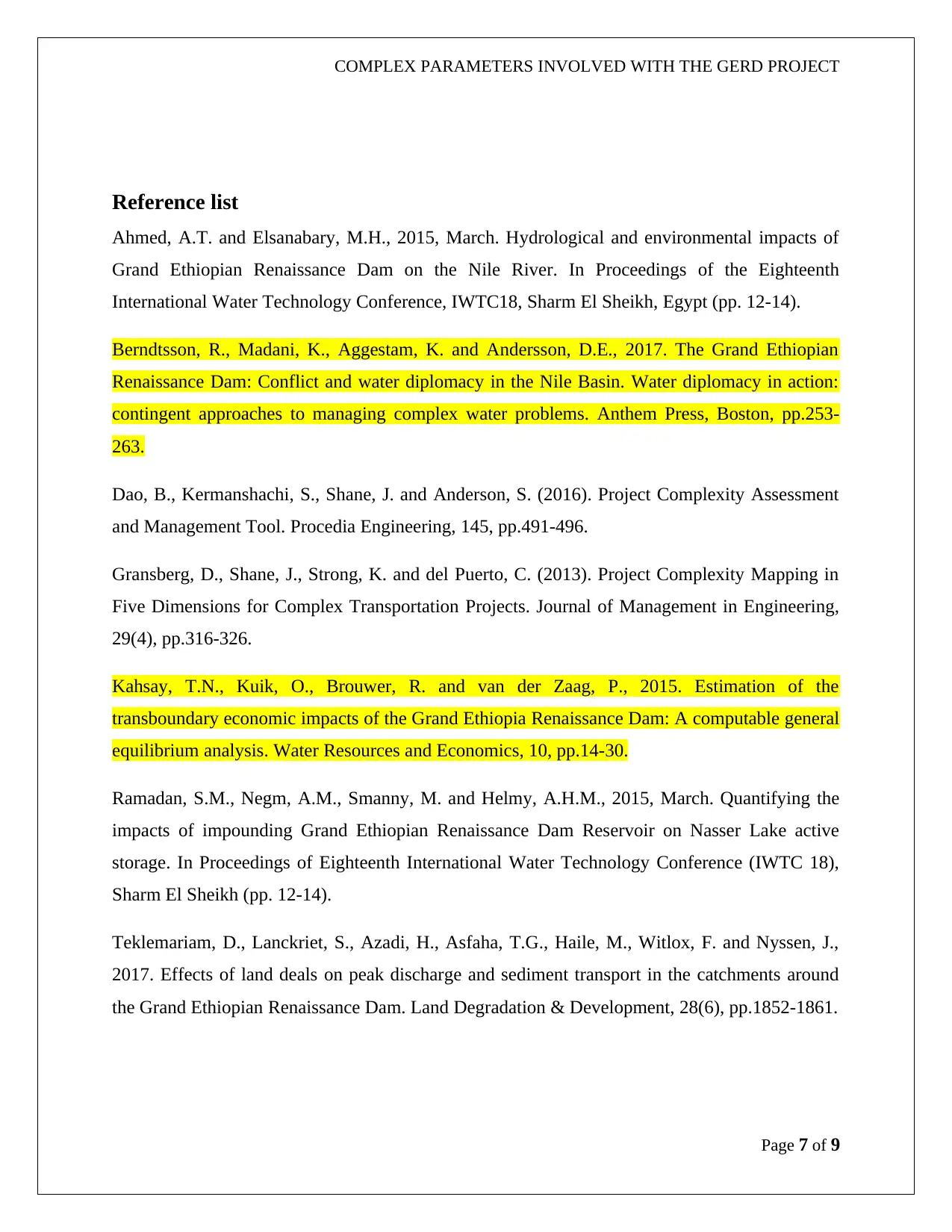
COMPLEX PARAMETERS INVOLVED WITH THE GERD PROJECT
Reference list
Ahmed, A.T. and Elsanabary, M.H., 2015, March. Hydrological and environmental impacts of
Grand Ethiopian Renaissance Dam on the Nile River. In Proceedings of the Eighteenth
International Water Technology Conference, IWTC18, Sharm El Sheikh, Egypt (pp. 12-14).
Berndtsson, R., Madani, K., Aggestam, K. and Andersson, D.E., 2017. The Grand Ethiopian
Renaissance Dam: Conflict and water diplomacy in the Nile Basin. Water diplomacy in action:
contingent approaches to managing complex water problems. Anthem Press, Boston, pp.253-
263.
Dao, B., Kermanshachi, S., Shane, J. and Anderson, S. (2016). Project Complexity Assessment
and Management Tool. Procedia Engineering, 145, pp.491-496.
Gransberg, D., Shane, J., Strong, K. and del Puerto, C. (2013). Project Complexity Mapping in
Five Dimensions for Complex Transportation Projects. Journal of Management in Engineering,
29(4), pp.316-326.
Kahsay, T.N., Kuik, O., Brouwer, R. and van der Zaag, P., 2015. Estimation of the
transboundary economic impacts of the Grand Ethiopia Renaissance Dam: A computable general
equilibrium analysis. Water Resources and Economics, 10, pp.14-30.
Ramadan, S.M., Negm, A.M., Smanny, M. and Helmy, A.H.M., 2015, March. Quantifying the
impacts of impounding Grand Ethiopian Renaissance Dam Reservoir on Nasser Lake active
storage. In Proceedings of Eighteenth International Water Technology Conference (IWTC 18),
Sharm El Sheikh (pp. 12-14).
Teklemariam, D., Lanckriet, S., Azadi, H., Asfaha, T.G., Haile, M., Witlox, F. and Nyssen, J.,
2017. Effects of land deals on peak discharge and sediment transport in the catchments around
the Grand Ethiopian Renaissance Dam. Land Degradation & Development, 28(6), pp.1852-1861.
Page 7 of 9
Reference list
Ahmed, A.T. and Elsanabary, M.H., 2015, March. Hydrological and environmental impacts of
Grand Ethiopian Renaissance Dam on the Nile River. In Proceedings of the Eighteenth
International Water Technology Conference, IWTC18, Sharm El Sheikh, Egypt (pp. 12-14).
Berndtsson, R., Madani, K., Aggestam, K. and Andersson, D.E., 2017. The Grand Ethiopian
Renaissance Dam: Conflict and water diplomacy in the Nile Basin. Water diplomacy in action:
contingent approaches to managing complex water problems. Anthem Press, Boston, pp.253-
263.
Dao, B., Kermanshachi, S., Shane, J. and Anderson, S. (2016). Project Complexity Assessment
and Management Tool. Procedia Engineering, 145, pp.491-496.
Gransberg, D., Shane, J., Strong, K. and del Puerto, C. (2013). Project Complexity Mapping in
Five Dimensions for Complex Transportation Projects. Journal of Management in Engineering,
29(4), pp.316-326.
Kahsay, T.N., Kuik, O., Brouwer, R. and van der Zaag, P., 2015. Estimation of the
transboundary economic impacts of the Grand Ethiopia Renaissance Dam: A computable general
equilibrium analysis. Water Resources and Economics, 10, pp.14-30.
Ramadan, S.M., Negm, A.M., Smanny, M. and Helmy, A.H.M., 2015, March. Quantifying the
impacts of impounding Grand Ethiopian Renaissance Dam Reservoir on Nasser Lake active
storage. In Proceedings of Eighteenth International Water Technology Conference (IWTC 18),
Sharm El Sheikh (pp. 12-14).
Teklemariam, D., Lanckriet, S., Azadi, H., Asfaha, T.G., Haile, M., Witlox, F. and Nyssen, J.,
2017. Effects of land deals on peak discharge and sediment transport in the catchments around
the Grand Ethiopian Renaissance Dam. Land Degradation & Development, 28(6), pp.1852-1861.
Page 7 of 9
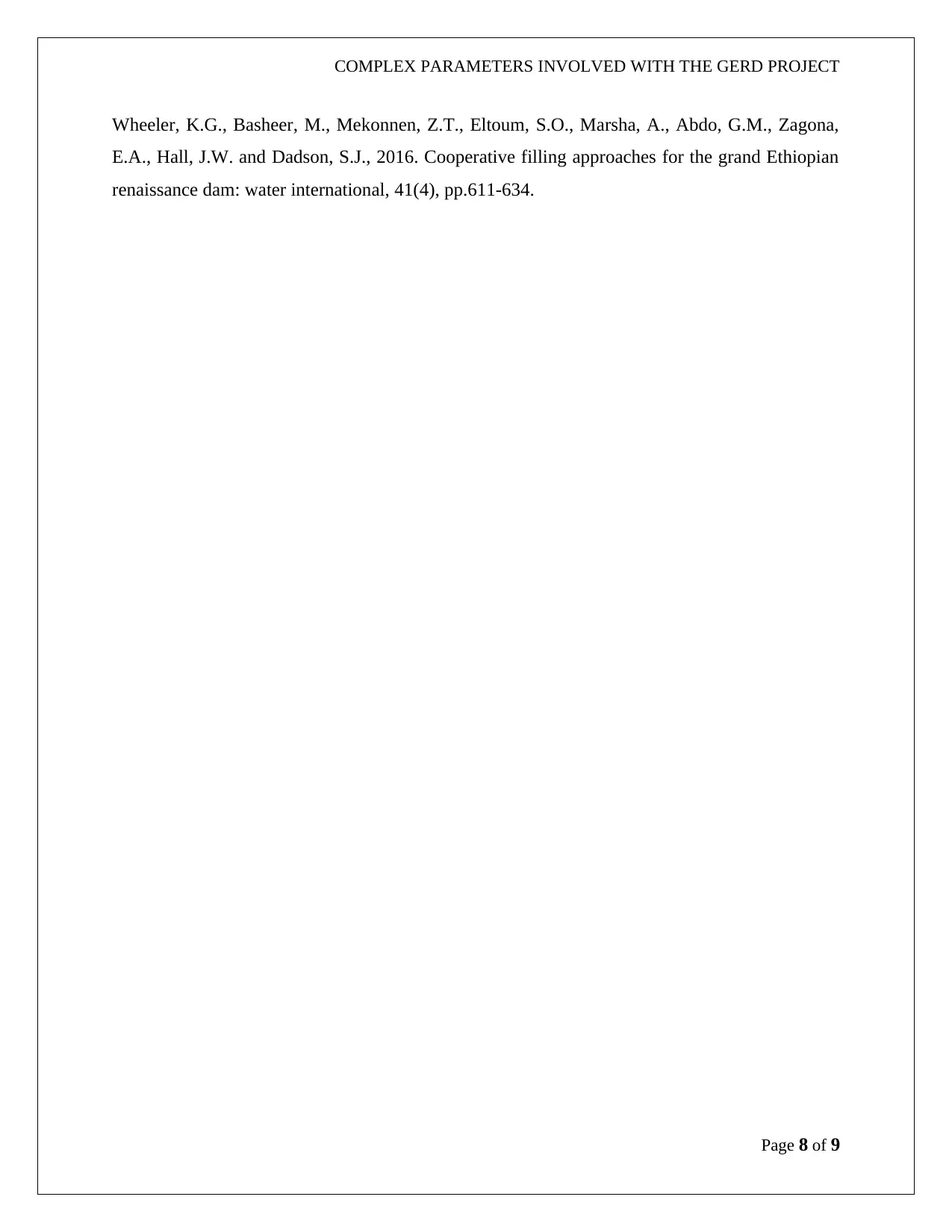
COMPLEX PARAMETERS INVOLVED WITH THE GERD PROJECT
Wheeler, K.G., Basheer, M., Mekonnen, Z.T., Eltoum, S.O., Marsha, A., Abdo, G.M., Zagona,
E.A., Hall, J.W. and Dadson, S.J., 2016. Cooperative filling approaches for the grand Ethiopian
renaissance dam: water international, 41(4), pp.611-634.
Page 8 of 9
Wheeler, K.G., Basheer, M., Mekonnen, Z.T., Eltoum, S.O., Marsha, A., Abdo, G.M., Zagona,
E.A., Hall, J.W. and Dadson, S.J., 2016. Cooperative filling approaches for the grand Ethiopian
renaissance dam: water international, 41(4), pp.611-634.
Page 8 of 9
⊘ This is a preview!⊘
Do you want full access?
Subscribe today to unlock all pages.

Trusted by 1+ million students worldwide
1 out of 9
Related Documents
Your All-in-One AI-Powered Toolkit for Academic Success.
+13062052269
info@desklib.com
Available 24*7 on WhatsApp / Email
![[object Object]](/_next/static/media/star-bottom.7253800d.svg)
Unlock your academic potential
Copyright © 2020–2025 A2Z Services. All Rights Reserved. Developed and managed by ZUCOL.





